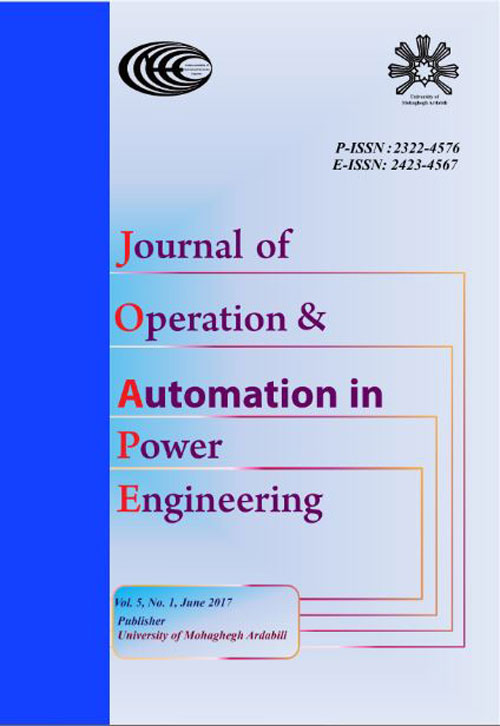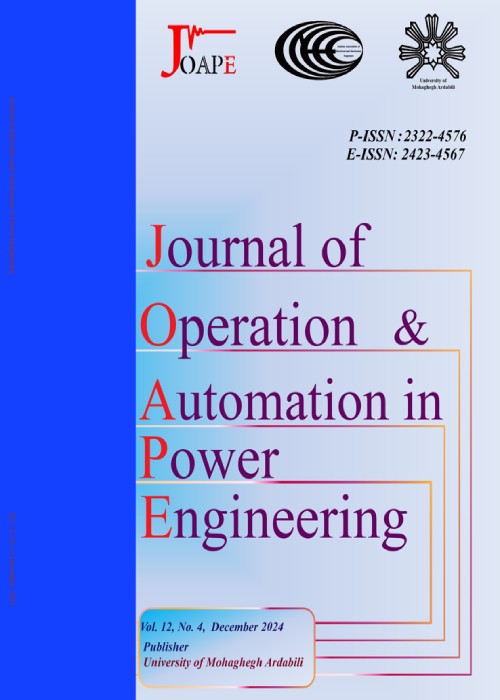فهرست مطالب

Journal of Operation and Automation in Power Engineering
Volume:5 Issue: 1, Winter - Spring 2017
- تاریخ انتشار: 1396/04/24
- تعداد عناوین: 9
-
-
Pages 1-10As an efficient alternative to fossil fuels, renewable energy sources have attained great attention due to their sustainable, cost-effective, and environmentally friendly characteristic. However, as a deficiency, renewable energy sources have low reliability because of their non-deterministic and stochastic generation pattern. The use of hybrid renewable generation systems along with the storage units can mitigate the reliability problem. Hence, in this paper, a grid connected hybrid micro-grid is presented, which includes wind and photovoltaic resources as the primary power sources and a hydrogen storage system (including fuel cell and electrolyzer) as a backup. A new power management strategy is proposed to perform a proper load sharing among the micro-grid units. Hybrid (distributed/central) control method is applied for the realization of the control objectives such as DC bus voltage regulation, power factor control, synchronous grid connection, and power fluctuation suppression. Distributed controllers have the task of fulfilling local control objectives such as MPPT implementation and storage unit control. On the other hand, the central control unit is mainly responsible for power management in the micro-grid. Performance and effectiveness of the proposed power management strategy for the presented micro-grid are verified using a simulation study.Keywords: Micro-grid, Power management, Wind, Photovoltaic, Fuel cell
-
Pages 11-18Power system state estimation is a central component in energy management systems of power system. The goal of state estimation is to determine the system status and power flow of transmission lines. This paper presents an advanced state estimation algorithm based on weighted least square (WLS) criteria by introducing virtual meters. For each bus of network, except slack bus, a virtual meter is considered, using the concept of KCL law. Regarding virtual meter, an improved state estimation algorithm is obtained with higher accuracy and lower computation burden. In the case study, at first, a simple 6-bus test system is presented and the proposed state estimation algorithm is followed step by step. Then, in order to evaluate the effectiveness and applicability of algorithm, IEEE 30-bus and IEEE 118-bus test systems are also taken into consideration. The obtained results verify the usefulness of the proposed method in large size power systems including thousands of buses.Keywords: Measurement error, Meter measurement, State estimation, Virtual meter, Voltage phase angle
-
Regulation of Electrical Distribution Companies via Efficiency Assessments and Reward-Penalty SchemePages 19-30Improving performance of electrical distribution companies, as the natural monopoly entities in electric industry, has always been one of the main concerns of the regulators. In this paper, a new incentive regulatory scheme is proposed to improve the performances of electrical distribution companies. The proposed scheme utilizes several efficiency assessments and a 3-dimentional reward-penalty scheme (3DRPS). Through efficiency assessments, economic efficiency and service quality, as two aspects of companies performances, are assessed and according to the results of such assessments, reasonable capital expenditure (CAPEX) and operational expenditure (OPEX) for each company are calculated. Then, according to the reasonable CAPEX and OPEX, allowed revenues are calculated for next regulatory period. Moreover, the 3DRPS on quality is used to encourage the companies to maintain and improve their service quality during the regulatory period. The 3DRPS gives the incentive to the companies based on changes in their quality indices. The incentives are added to companies allowed revenues. Finally, the proposed scheme is applied to Iranian distribution companies and the results are discussed.Keywords: Efficiency assessment, Reward-penalty scheme, Distribution company regulation
-
Pages 31-42In this paper, a new structure of step-up dc-dc converter by using coupled inductor and active-clamped circuit is proposed. The proposed converter generates high voltage gain in comparison with the conventional dc-dc converters. Duo to using active-clamped circuit in the proposed topology the voltage stress on main switch is reduced. In addition the zero voltage switching (ZVS) in ON-state of main switch is obtained. In this paper the performance of the proposed structure is investigated in continues current mode (CCM) and discontinues current mode (DCM). Moreover, the voltage gain in CCM and DCM operations are calculated. To prove the correctness operation and also the given equations, the simulation results in PSCAD/EMTDC software are used.Keywords: Coupled-inductor, Step-up converter, Active-clamped circuit, Zero voltage switching
-
Pages 43-50This paper presents the movement dynamic of the train and the relationship between the speed of wheel and train, as well as a discussion about the concept of wheel slip. There are two different operation regions designated as creep and wheelspin areas for wheel slip. Creep and wheelspin areas have stable and unstable characteristics, respectively. Wheels and rails are constructed from iron, and thus the friction between them is negligible. Therefore, operation point of speed control system may be in either creep or wheelspin areas. The place of the operation point depends on the values of driving torque compared with the value of maximum adhesion torque. As described, in this article too, in order to minimize the acceleration time, the best operation point is maximum adhesion point. To provide a situation to study algorithms of adhesion control, this paper presents a complete model for simulation the adhesion control. Adhesion coefficient is a non-measurable quantity; therefore, an estimator, previously used, for its estimation is used. The traction motor which is used in this study is an induction motor. The speed control system of this traction motor is field oriented control. The presented model is used in operation in creep/wheelspin area and on maximum adhesion point. The simulation results approve the model.Keywords: AC Drives, Adhesion coefficient, Electrical trains, Traction system, Wheel slip
-
Pages 51-60The Optimal Power Flow (OPF) is one of the most important issues in the power systems. Due to the complexity and discontinuity of some parameters of power systems, the classic mathematical methods are not proper for this problem. In this paper, the objective function of OPF is formulated to minimize the power losses of transmission grid and the cost of energy generation and improve the voltage stability and voltage profile, considering environmental issues. Therefore, the OPF problem is a nonlinear optimization problem consisting of continuous and discontinuous variables. To solve it, Non-dominated Sorting Genetic Algorithm-II (NSGA-II) and a new hybrid algorithm combining modified Particle Swarm Optimization (PSO) and Genetic algorithm (GA) methods are proposed. In this method, each of the algorithms is performed in its procedure and generates the primary population; then, the populations are ordered and from among them, populations with the highest propriety function are selected. The first population that guesses will enter the two algorithms procedures for generating the new population. Note that the inputs of the two algorithms are the same; then, generates a new population. Now, there are three groups of populations: one created by modified GA, one created by modified PSO, and the other is the first initial population, and then sorted with the described sorting method.Keywords: Optimal power flow, Multi-objective, Genetic Algorithm, Particle swarm optimization
-
A Robust Discrete FuzzyP+FuzzyI+FuzzyD Load Frequency Controller for Multi-Source Power System in Restructuring EnvironmentPages 61-74In this paper a fuzzy logic (FL) based load frequency controller (LFC) called discrete FuzzyP᛬辅물 (FPᒏ) is proposed to ensure the stability of a multi-source power system in restructured environment. The whale optimization algorithm (WOA) is used for optimum designing the proposed control strategy to reduce fuzzy system effort and achieve the best performance of LFC task. Further, to improve the system performance, an interline power flow controller (IPFC) and superconducting magnetic energy system (SMES) is included in the system. Governor dead band, generation rate constraint, and time delay are considered as important physical constraints to get an accurate understanding of LFC task. The performance of the optimized FPᒏ controller is evaluated on a two area six-unit hydro-thermal power system under different operating conditions which take place in a deregulated power market and varying system parameters in comparison with the classical fuzzy PID controller. Simulation results shows that WOA based tuned FPᒏ based LFC controller are relatively robust and achieve good performance for a wide change in system parameters considering system physical constraints.Keywords: Load Frequency Control, FP+FI+FD, Whale optimization control, Multi-source power system
-
A Soft Switched DC-DC Boost Converter for Use in Grid Connected InvertersPages 75-82This paper presents a soft-switching DC-DC boost converter, which can be utilized in renewable energy systems such as photovoltaic array, and wind turbine connections to infinite bus of a big power network, using grid connected inverters. In the proposed topology for the DC-DC boost converter, the main and the auxiliary power switches are turned on and turned off with zero voltage switching (ZVS) and zero current switching (ZCS), respectively. Furthermore, by applying soft-switching techniques to driving power switches, the power losses and stresses associated with commutation of power devices decrease significantly. The efficiency of the proposed soft-switched DC-DC converter at various output powers is compared with that of the traditional DC-DC converter and a few topologies proposed in recent literature. This comparison indicates that the proposed DC-DC boost converter is much more efficient around the rated power (1 kW). The power topology and the control strategy applied to the proposed soft-switched DC-DC boost converter, which is connected to a grid-tied inverter, are analyzed theoretically by simulation studies. Moreover, an experimental prototype is implemented to verify the theoretical analysis and the simulation studies.Keywords: Soft switching, DC-DC converter, Zero voltage switching (ZVS), Zero current switching (ZCS), Grid connected inverters, Renewable energy systems
-
Yaw Rate Control and Actuator Fault Detection and Isolation for a Four Wheel Independent Drive Electric VehiclePages 83-95In this paper, a new actuator fault detection and isolation method for a four wheel independent drive electric vehicle is proposed. Also, a controller based on sliding mode control method is proposed for lateral stability of the vehicle. The proposed control method is designed in three high, medium and low levels. At the high-level, the vehicle desired dynamics such as longitudinal speed reference and yaw rate reference are determined. The medium-level is designed to achieve desired traction force and yaw moment based on the sliding mode control. At the low-level, by defining and optimally minimizing a cost function, proper force or torque signals are determined to apply to the wheels. Moreover, this paper also presents a new method for actuator fault detection and isolation in electric vehicles. The proposed fault detection method uses comparison of sliding ratio of different wheels. Using the proposed method, value of the actuator fault and its position are accurately estimated and diagnosed. Then, the proposed controller is modified and adapted to new conditions using the fault identification results. Finally, the validity of proposed controller is confirmed by the conducted simulations in MATLAB and CARSIM environments.Keywords: Fault detection, Four wheel drive electric vehicle, Sliding Mode Control, Vehicle lateral stability


